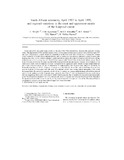| dc.contributor.author | Wright, C. | |
| dc.contributor.author | Kgaswane, E.M. | |
| dc.contributor.author | Kwadiba, M.T.O. | |
| dc.contributor.author | Simon, R.E. | |
| dc.contributor.author | Nguuri, T.K. | |
| dc.contributor.author | McRae-Samuel, R. | |
| dc.date.accessioned | 2009-02-13T10:28:53Z | |
| dc.date.available | 2009-02-13T10:28:53Z | |
| dc.date.issued | 2003 | |
| dc.identifier.citation | Wright, C. et al (2003) South African seismicity, April 1997 to April 1999, and regional variations in the crust and uppermost mantle of the Kaapvaal craton, Lithos. Vol. 71, No. 2-4, pp. 369-392 | en |
| dc.identifier.issn | 0024-4937 | |
| dc.identifier.uri | http://hdl.handle.net/10311/280 | |
| dc.description.abstract | Events induced by deep gold-mining activity on the edge of the Witwatersrand basin dominate the seismicity of South
Africa. The deployment of 54 broad-band seismic stations at 84 separate locations across southern Africa between April 1997
and April 1999 (Kaapvaal network) enabled the seismicity of South Africa to be better defined over a 2-year period. Seismic
events located by the South African national network, and by localized seismic networks deployed in mines or across goldmining
areas, were used to evaluate earthquake location procedures and to show that the Kaapvaal network locates mininginduced
tremors with an average error of 1.56 ± 0.10 km compared with 9.50 ± 0.36 km for the South African network. Travel
times of seismic events from the mines recorded at the Kaapvaal network indicate regional variations in the thickness of the
crust but no clearly resolved variations in seismic wavespeeds in the uppermost mantle. Greater average crustal thicknesses
(48–50 km compared with 41–43 km) are observed in the northern parts of the Kaapvaal craton that were affected by the
Bushveld magmatism at 2.05 Ga. Estimates of average crustal thickness for the southern part of the Kaapvaal craton from
receiver functions (38 km) agree well with those from refracted arrivals from mining-induced earthquakes if the crustal
thicknesses below the sources are assumed to be 40–43 km. In contrast, the average crustal thickness inferred from refracted
arrivals for the northern part of the Kaapvaal craton is larger by about 7 km (51 km) than that inferred from receiver functions
(44 km), suggesting a thick mafic lower crust of variable seismic properties due to variations in composition and metamorphic
grade. Pn wavespeeds are high (8.3–8.4 km/s), indicating the presence of highly depleted magnesium-rich peridotite throughout
the uppermost mantle of the craton. Seismic Pg and Sg phases indicate that the upper crust around the Witwatersrand basin is
comparatively uniform in composition when averaged over several kilometres. | en |
| dc.language.iso | en | en |
| dc.publisher | Elsevier Science Ltd. www.elsevier.com/locate/lithos | en |
| dc.subject | Crustal thickness | en |
| dc.subject | Kaapvaal craton | en |
| dc.subject | Mining-induced earthquakes | en |
| dc.subject | Composition of crust | en |
| dc.subject | Composition of uppermost mantle | en |
| dc.title | South African seismicity, April 1997 to April 1999, and regional variations in the crust and uppermost mantle of the Kaapvaal craton | en |
| dc.type | Article | en |

